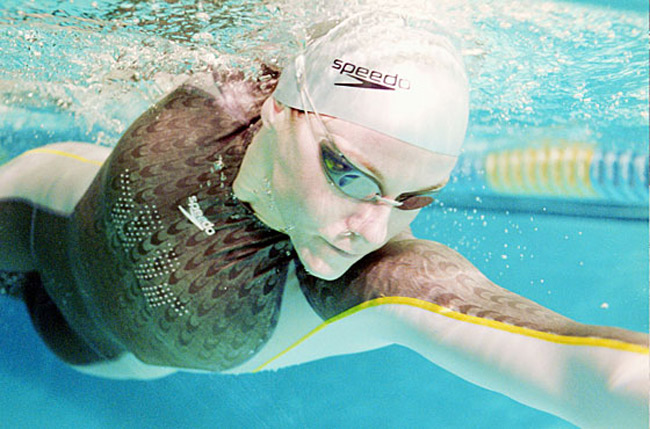
Good swimming is about using the core of your body-namely the hips, stomach, lower back and chest. Top swimmers rotate the core of their body from one side to the other, while keeping the head fixed. When you rotate in this way, you move through the water more like a fish, or a boat, reaching further forward on each stroke, and maximizing your efficiency.
Here are tips to teach you how to swim faster and smoother, saving more energy for the bike and run.
Water is 1,000 times denser than air, so the single most important factor is to slip your body through the smallest hole in the water. Imagine a central axis extending from the top of your head to the opposite end of the pool. Rotate your body along this axis with each stroke, stretching your leading arm as far forward as you can. Keep the muscles in your lower back and abs taut as you power through the water – doing so will keep the propulsion coming from both your arms and legs.
Swimming with just your hands is like jumping with just your feet. Instead, grip the water with your entire forearm and hand, holding your forearm at a right angle to your upper arm and digging in like you’re gathering sand with a shovel. Keep your hands broad, flat and firm. You’re not pushing your arm through the water as much as anchoring it and pulling your body over it.
Each stroke begins with your leading arm having entered the water, and that side of your body – the low side – pointing almost at the bottom of the pool. The other side of your body – the high side – should be raised, with the arm that just finished its stroke getting ready to return to the water. Power is triggered when you drive down the high side of your body, throwing your high-side arm forward along the central axis into the leading position and rotating your hips and torso. Meanwhile, your low-side arm is the pulling arm underwater, working with your rotating torso to provide acceleration.
Freestylers used to hold their heads high. That forced the rest of the body to drop, turning it into a high-drag plough. One must look pretty much straight down at the bottom of the pool, not only does this cut drag, it keeps your torso high, reducing strain on your neck and lower back.
In the pool, fewer strokes is better. Your goal should be a high distance per stroke (DPS). Elite swimmers like Phelps can easily traverse a 25m pool in seven strokes (each hand entry counts as a stroke). Try to keep yours below 20 by conserving momentum. Pull yourself over your anchor and continue to glide forward with one arm forward and the other back. You’ll travel further and faster with your legs streamlined near your axis. When you begin to slow, start the next stroke.
The secret is turning your feet into fins. Here again, leverage rules: your legs should be taut, scissoring you through the water, while your feet remain flexible. This will help them snap at the downstroke of each kick, adding oomph and helping twist your torso along the central axis. If your feet don’t flex well, buy a set of fins to add flexibility.
Gasping for air every time your head nears the surface is a great way to drown. Instead, make each breath count. Emphatically exhale the air from your lungs (all of it, not just 90 per cent) before taking a quick, full breath on the high side. Beginning swimmers need to breathe after each stroke, but as your endurance improves, try breathing on alternate sides – that is, after three strokes. It’ll reduce the strain on your neck and shoulders that results from always breathing on the same side.
Your form is great in training but as soon as the gun goes off in a triathlon, you forget how to perform. It’s happened to us all: you start to flail your arms, and all you can see when you lift your head is a sea of other triathletes powering away from you. Swimming fast at the start of a triathlon can sabotage your form, so the challenge is to maintain your efficiency at high intensities.
Swimming drills are a set of swimming exercises aiming at improving the technique and speed of swimmers. To get a better technique and to improve your coordination ability you should do swimming drills during every swimming training session.
Warm up for five minutes, then do this 500m test. Start at a pace you can hold for more than 500m, but build gradually so that your last 100m is at 90 per cent effort. Count your strokes per length (SPL) in the first and last 100m. In order to improve your threshold, swim 100m repeats for 20 to 30 minutes, resting after each set for a quarter of the time you were swimming. So, if you swam 100m in four minutes, rest for one minute before beginning the next set. Swim at the fastest pace that allows you to keep an SPL count one or two strokes below your count in the final 100m of your test.
Keep Swimming! Stay Fit!
Ref:
